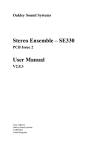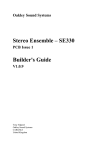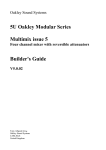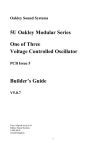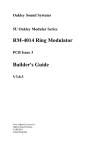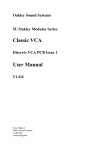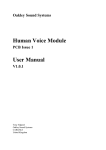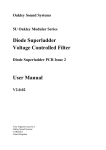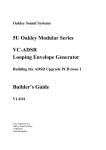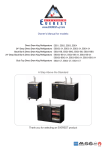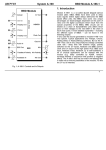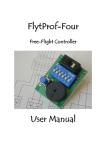Download SE330 Issue 1 User Manual
Transcript
Oakley Sound Systems Stereo Ensemble – SE330 PCB Issue 1 User Manual V1.0.2 Tony Allgood Oakley Sound Systems CARLISLE United Kingdom Introduction This is the User Manual for the issue 1 Stereo Ensemble SE330 module from Oakley Sound. This document contains an overview of the unit and goes into some detail regarding the operation of the module. It also contains the calibration instructions. For the Builder's Guide, which contains a basic introduction to the circuit board and a full parts list for the components needed to populate the board, please visit the main project webpage at: http://www.oakleysound.com/se330.htm For general information regarding where to get parts and suggested part numbers please see our useful Parts Guide at the project webpage or http://www.oakleysound.com/parts.pdf. For general information on how to build our modules, including circuit board population, mounting front panel components and making up board interconnects please see our generic Construction Guide at the project webpage or http://www.oakleysound.com/construct.pdf. 2 The Oakley Sound SE330 The Oakley SE330 is a 'mono in, stereo out' ensemble unit designed to mimic the behaviour of the multichannel chorus and ensemble units of late 1970s and early 1980s. The SE330 uses four channels of bucket brigade delay (BBD) lines and four voltage controlled low frequency oscillators (VC-LFO) to achieve a sound reminiscent of the Japanese string machines, guitar chorus pedals and studio rack effects of yesteryear. Unlike the original devices the SE330 allows greater control over the modulation depths, speeds and waveforms, as well as featuring a wet/dry control. The SE330 features three basic modes: Quad ensemble: All four delay lines are operating in this mode – with two BBDs and two VC-LFOs being used for each stereo channel. This mode is at its most effective when the wet/dry control is set to around 100% wet. Stereo ensemble: In this mode two BBDs are being used, one per stereo channel. Each BBD can be modulated by its own pair of VC-LFOs. This mode is very effective when the wet/dry control is set to around 50%. Dimension: Again, in this mode, two BBDs are being used. But this time both BBDs are being driven from the same pair of VC-LFOs. However, one of the BBDs will receive the inverted outputs of the VC-LFO pair. Like mode 2, this mode is very effective when the wet/dry control is set to around 50%. The four VC-LFOs are made from four separate circuits. Two of the LFOs produce sine waves and two of them produce triangle waves. The SE330 is wired so that each stereo channel's BBDs are controlled by one set of triangle and sine wave LFOs. Each pair of similar waveform VC-LFOs are controlled by one set of speed and depth pots. So one set of pots controls the two sine wave LFOs and one set controls the two triangle wave LFOs. Each pair of similar waveform LFOs will therefore track each other but one is set to always run 20% faster than the other. An effective compander circuit reduces the inevitable noise created by the analogue delay lines to a respectable level. A peak LED lights when the input signal is getting too big and noticeable distortion would result. Input and output level control pots are also provided to allow maximum flexibility in dealing with a variety of input signal levels. Both the input and output connections are balanced but can be used with unbalanced connections if desired. The power to the unit should be a regulated split supply of +/-12V to +/-17V. Power is admitted onto the main circuit board via a four way 0.156” (2.96mm) header of MTA or KK type. The module can be powered by our own Rack Power Supply Unit (RPSU) or any other MOTM compatible supply such as the Oakley PSU . Power consumption is +140mA and -110mA at +/-15V The printed circuit board size is 198mm (width) x 234mm (depth). 3 Operating Instructions INPUT LEVEL The input level should be set so that the peak LED never lights continuously. The brighter the LED shines the more you are overdriving the unit and this is generally to be avoided. Ideally, the peak LED should never come on in normal operation. Once the input level is set to the correct point then the output level control can be adjusted to suit. PEAK LED This gives a visual indication of when the signal being sent to the delay line circuitry exceeds the recommended amount. As soon as the LED starts to glow the delay line circuitry will be close to clipping and distorting. The level required to clip the delay lines varies with frequency and the harmonic content of the signal. Brighter sounds, or ones of very high pitch, are more likely to clip than low frequencies. For example; a static sine wave at 200Hz will clip at 3.6V peak-peak. While at 2kHz clipping will start at 1.2V peak to peak. TRIANGLE RATE Controls the rate of the triangle wave low frequency oscillator (LFO). An LFO produces an output signal that changes in voltage with a repeatable and periodic shape. The triangle wave output rises at a constant rate, reaches an apex and then descends at the same rate as it went up. Then at its lowest point it rises again and the process repeats itself. It is called a triangle wave because when viewed on an oscilloscope the trace is made from a series of triangles. TRIANGLE DEPTH Controls the depth of the triangle wave modulation. The deeper the modulation the greater the change in delay times the BBD lines exhibit. Quick changes in delay are heard as a change in pitch by the listener. With a triangle wave the pitch changes can be quite severe as the waveform changes direction. 4 SINE RATE Controls the rate of the sine wave LFOs. A sine wave is similar to the triangle wave but the rises and falls in output voltage are more gentle. The waveform is more akin to natural resonances slowing down before it changes direction. SINE DEPTH Controls the depth of the sine wave modulation. Sine waves produce a more natural sounding pitch change when they modulate a BBD. BALANCE This adjusts the mix between the unaffected signal and the one coming from the delay line or lines. DRY is the unaffected signal while WET is the delayed signal. MODE SWITCH This sits between the two right most pots and is key to understanding what the modulation section of the SE330 does. It has three positions; dimension, stereo and quad. There are four bucket brigade delay lines in the SE330. Each side of the stereo signal has two dedicated BBDs and each BBD has its own driver circuitry which controls the delay imparted by the BBD. These driver circuits are modulated with low frequency oscillators. Thus each LFO can alter the delay time exhibited by the BBD it controls. There are four LFOs in the SE330 but they are not connected so that one LFO controls its own BBD. This should work well but in practice it doesn't give the sound of the classic Japanese string machines and effects units that we want to hear. So the SE330 does something much more complicated and, in doing so, can mimic most of the well known ensembles units of the past. Dimension Mode This is the simplest of the SE330's three modes. Only two BBD lines are used in this mode, one for the left hand channel and one for the right. The mono input is shared equally to each BBD's input. Each BBD produces a similar delay when not modulated so that the sound from both left and right is more or less the same. Two LFOs, one whose output is a triangle wave, the other, whose output is a sine wave, are used as modulation sources. The rate and depth of each LFO is controllable from the front panel controls. Both BBDs are modulated by the sum of both LFOs. That is, both LFOs control both BBDs together. However, there is one important difference between the modulating signals that are sent to each BBD. The BBD that affects the right hand side operates inversely to the left hand one. So that when the delay of the left hand BBD is increasing, the right hand one is decreasing. 5 When listened to dry the overall effect is like an odd form of panning and vibrato at the same time. But when the balance pot is turned to around 50% a subtle chorus sound is heard. Stereo Ensemble Mode This mode is similar to the dimension mode but features four LFOs and not just two. Instead of the right hand BBD being modulated by the inverse of the same LFOs that control the left hand side, this time the right hand BBD gets its own pair of triangle and sinewave LFOs. However, these LFOs are not completely independent of the left hand side ones. The rate and frequency controls are shared with the left hand LFOs. Therefore the right hand side LFOs will track the frequency and amplitude of the left hand side LFOs. The only difference between the two sides are that the right hand side LFOs always run 20% faster than the left hand side. This keeps things relatively stable across the stereo panorama, yet, because of the free running nature of all four LFOs, things are different enough between the channels to give a wide ensemble sound. Quad Ensemble Mode The RS or VP ensemble mode. The third mode is the most complex. The basic behaviour is the same as the stereo mode, but the quad mode adds an extra BBD line to each stereo channel. This additional BBD is only controlled by the triangle LFO and not the sine wave LFO. However, it responds inversely to the other BBD on its channel. So as the other BBD is increasing in delay, the extra one is decreasing. And because it doesn't respond to the sine wave LFO, the output of the BBD can be very different to the other BBD on the same channel. This creates a rich rolling sound. The classic RS or VP string sound involves only the effected sound, ie. 100% wet. The triangle wave LFOs being set to fairly slow (one cycle around 5 seconds) but deep modulations. And then with a much smaller amount of faster (around 5Hz) sine wave modulation added. POWER LED This will light when power is applied to the unit. To be precise, it lights when the positive power supply rail is up and running. OUTPUT LEVEL This adjusts the output level of the unit. The gain of the whole module is +6dB when being driven with an unbalanced audio signal. 6 Input and Output Connections The SE330 has both balanced input and output connections. It is expected that the unit will be fitted with three pole TRS (tip-ring-sleeve) sockets. Both input and output are compatible with unbalanced signals and mono jack plugs can be used without detriment to the SE330 It should work fine with signal levels direct from a mixer, line level synthesisers and modular synthesisers. The input impedance is too low to work direct from guitars unless they are fitted with internal pre-amplifiers. The maximum input signal level without clipping the pre-amplifier stage is +/-12V if the SE330 has a +/-15V internal supply. Signal levels higher than +/-30V have the potential to damage the unit. Input impedance is 44K. Output impedance is 220R. 7 Calibration There are sixteen trimmers on the SE330. It will be useful to have access to an oscilloscope and a frequency counter for the calibration routine, however, it is not necessary as most adjustments can be done with just your ears and a voltmeter. All voltages should be measured with respect to a suitable 0V point. That is the black lead of your meter should be connected to 0V. 0V is most easily found at the cathode of D18 – the end that is nearest to the power header. CLK1 This sets the delay time of BBD line number 1. If you have no scope or frequency counter then adjust CLK1 so that pin 1 of U12 is approximately 3.30V. If you have access to a scope or frequency counter then measure the signal at pin 6 of U6. Adjust CLK1 so that the frequency of the square wave is approximately 75kHz. CLK2 This sets the delay time of BBD line number 2. If you have no scope or frequency counter then adjust CLK2 so that pin 1 of U32 is approximately 3.30V. If you have access to a scope or frequency counter then measure the signal at pin 6 of U17. Adjust CLK2 so that the frequency of the square wave is approximately 75kHz. CLK3 This sets the delay time of BBD line number 3. If you have no scope or frequency counter then adjust CLK3 so that pin 7 of U26 is approximately 3.30V. If you have access to a scope or frequency counter then measure the signal at pin 6 of U6. Adjust CLK3 so that the frequency of the square wave is approximately 75kHz. CLK4 This sets the delay time of BBD line number 4. If you have no scope or frequency counter then adjust CLK4 so that pin 7 of U32 is approximately 3.30V. If you have access to a scope or frequency counter then measure the signal at pin 6 of U35. Adjust CLK1 so that the frequency of the square wave is approximately 75kHz. 8 OFF1, OFF2, OFF3 & OFF4 These adjust the bias point of the respective BBD line's input signal. If this voltage offset is set too high or too low then the output signal of that BBD will distort too easily. Input a triangle wave or smooth sounding tone into the SE330. You can use a keyboard and hold down the A key to give you a constant 440Hz tone. Try not to make it too bright and don't use a square wave. Adjust the input level so that the peak LED is just starting to glow dimly. Turn down both modulation depth pots and set the balance pot to wet. Select dimension mode. Listen to the left output of the SE330 only and adjust OFF2 so that the sound is not distorting. There will be a point at which the sound is not distorting noticeably while either side of it sounds thinner and grubbier. Now select quad mode. The sound from the left channel will be louder. Adjust OFF1 until the sound is not distorting noticeably. Listen to the right hand output only and select dimension mode again. Adjust OFF4 so that the sound is not distorting. Now select quad mode. Adjust OFF3 until the sound is not distorting noticeably. NULL1, NULL2, NULL3 & NULL4 These adjust the amount of high frequency clock breakthrough into the audio output. You want to set these so that the smallest amount of clock is getting through to the output. If you have no scope then just set this trimmer to its middle position. Although this sounds pretty imprecise it's actually not too far from the perfect setting. If you have access to a scope you can tweak it more exactly. Set your scope's time base to 5uS per division and the scaling to 200mV per division. Immediately below the TL072 op-amp in each delay section on the PCB there is a small ceramic capacitor. For BBD1 this is C17. Just below this capacitor is a resistor. It's not clear which resistor this is as its name is underneath it – it's actually R19 for BBD1. The left hand pad of this resistor is the point you need to measure for each BBD. Adjust the relevant NULL trimmer so that the waveform amplitude seen on the scope trace is minimised. Set incorrectly you'll see a kind of spiky square wave. Set correctly the trace will reduce to just a series of spikes. Do this for all four BBD lines. T_FRQ This sets the frequency range of the triangle LFOs. Insert an audio input into the SE330. The A440 note is a good one to use again. Set the triangle rate and triangle depth pot to their middle settings. Set the sine wave pots to their minimum. Select the dimension mode and turn the balance control to wet. Make sure the peak LED is not lit and listen to the left output only. You should hear the pitch being modulated. Adjust T_FRQ so that you hear the dee-dah sound repeating once a second. 9 If you have a 'scope, monitor the voltage at pin 1 of U3. Set the triangle rate pot to its maximum value and adjust T_FRQ until you get a 50Hz triangle wave. T_LVL This sets the maximum output level of both triangle wave LFOs. Without a 'scope this is difficult to set exactly but it doesn't really matter that much. Simply adjust the trimmer to its middle position and you should find that the depth pot goes from nothing to all out freaky vibrato. If you do have a 'scope then set the triangle rate and depth pots to their maximum. Then monitor the voltage on pin 1 of U11 and adjust T_LVL until you get a 10V peak to peak signal. S_FRQ This sets the frequency range of the sine wave LFOs. Insert an audio input into the SE330. The A440 note is a good one to use again. Set the sine rate and sine depth pot to their middle settings. Set the triangle wave depth pots to their minimum. Select the dimension mode and turn the balance control to wet. Make sure the peak LED is not lit and listen to the left output only. You should hear the pitch being modulated again but much more smoothly than with the triangle wave LFO. Adjust S_FRQ so that you hear a ee-aw sound repeating once a second. If you have a 'scope, monitor the voltage at pin 1 of U22. Set the sine rate pot to its maximum value and adjust T_FRQ until you get a 50Hz sine wave. T_LVL This sets the maximum output level of both sine wave LFOs. Without a 'scope this is difficult to set exactly but it doesn't really matter that much. Simply adjust the trimmer to its middle position and you should find that the depth pot goes from nothing to all out freaky vibrato. If you do have a 'scope then set the triangle rate and depth pots to their maximum. Then monitor the voltage on pin 1 of U31 and adjust T_LVL until you get a 10V peak to peak signal. 10 Final Comments I hope you enjoy using the Oakley Sound SE330. If you have any problems with the module, an excellent source of support is the Oakley Sound Forum at Muffwiggler.com. If you have a comment about this user manual, or have a found a mistake in it, then please do let me know either via e-mail or the forum. Tony Allgood at Oakley Sound Cumbria, UK © August 2013 No part of this document may be copied by whatever means without my permission. 11











